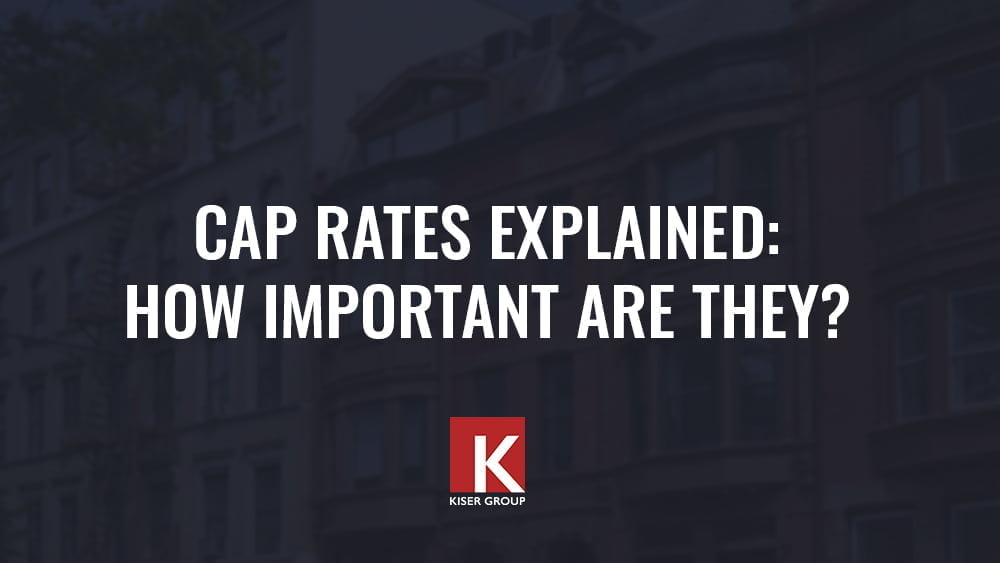06.17.20
Cap Rates Explained: How Important Are They?

A capitalization rate, more commonly referred to as a cap rate, is a metric commercial real estate investors use to analyze properties and calculate the rate of return. The cap rate is calculated by dividing the net operating income of the property by the initial cost basis or purchase price of the investment. Cap rates are used to gauge the risk level of an investment – lower cap rate, lower investment risk. Kiser Group’s Danny Mantis, Ron Plonis and Andy Friedman share the pros and cons of using a cap rate to evaluate a multifamily investment.
So, how important are cap rates?
“In theory, cap rate is important because it provides a property’s return calculation. Because people don’t buy things all cash, it doesn’t paint an accurate picture. Therefore, in practice, it’s a high-level metric that helps compare a specific deal to the market – similar to price per unit, GRM or price per square foot.” – Danny Mantis
“Generally, it’s very important for ensuring the return/net income for the asset, is commensurate with the risk (low beta…low cap, high beta…high cap). This is one of the most important criteria for comparing the demographic, or sector and risk of an asset with other recent sales.” – Ron Plonis
Why are institutional firms attracted to lower cap rate deals?
“For the same reason institutional investors invest in bonds and dividend paying stocks, and they are attracted to lower cap rate deals because they are typically reliable and predictable investments. Institutional investors that invest in real estate look to find easy to manage properties in markets that have strong economic fundamentals and are willing to make that safe investment for a reliable, but modest return. With all that said, institutions aren’t one dimensional and some do invest their capital into more ‘opportunistic’ real estate deals so long as their fund is set up to do so.” – Danny Mantis
“They are not necessarily attracted to lower cap rates, in some cases they are creating them. institutional buyers have access to capital at a lower cost basis, due to their scale, operational capabilities and track record. A private investor has a cost of funds ranging from 3-5% (300 to 500 basis points) while an institution is 2-4.5% (200-450 basis points). So for the same asset in the same market, an institutional buyer can achieve the same returns as a private buyer, while paying up to 125 basis points more. Therefore, institutional investors are still able to achieve their investment goals despite the lower cap rates they have created.” – Ron Plonis
Why are some investors only interested in 10 caps/high cap rate deals?
“If a 10% return on investment sounds good, realize that with leverage, that 10% cap can equate to a 20% or higher cash-on-cash return, depending on leverage levels and interest rate. A good portion of that return is also sheltered from taxes through depreciation. Any 10% cap apartment building is going to have hair of some sort on it (as in a toupee), but for those that can deal with the hair there is a big reward. A portfolio approach would lessen individual building risk yet still allow for above average total return.” – Andy Friedman
“Big risk equals big reward. Investors who are attracted to high cap rate deals are more entrepreneurial, they like to invest in real estate that might be tougher to rent or manage in hopes of producing large cash flow for themselves.” – Danny Mantis
“In my opinion, maybe the investor just completed their first real estate investment seminar. Investors that are singularly focused on high cap rate deals typically overlook many real costs attributed to high risk assets including increased turnover costs, higher delinquency rates, and challenging employment or population growth. All of these factors create lost income, increased expenses and headaches, which reduces the asset’s actual value.” – Ron Plonis
How do cap rates in Chicago/Chicagoland compare to other major metros?
“Cap rates in Chicagoland can vary quite considerably by submarket, as in many other major metros. A submarket’s cap rate is directly underpinned by population trends, employment sector risk and household formation. Major metros with similar underpinnings, in most cases, should have comparable cap rates.
“For those metros with demographically similar submarkets, one will find a disparity in cap rates when the market has priced in future risk(s) that are independent of demographics. One such risk may be future property tax liabilities. The likelihood of increased property taxes in Cook County, for example, would be factored into the cap rates, simply because prospective buyers are pricing in that increased liability created by the political mismanagement of pensions and various municipalities.” – Ron Plonis
What else should investors use besides the cap rate to evaluate a deal?
“Understand the demographic and employment picture and trends that underpin the “market cap rate.” In other words, work with a seasoned multifamily advisor to understand the demographic, employment and transit factors that created the prevailing comparable cap rates. Then confirm the subject asset you’re evaluating has the same, or like, population, employment, etc.” – Ron Plonis
“In my opinion the most important number anyone should consider in evaluating a deal is cash-on-cash return.” – Danny Mantis
Are there flaws to evaluating a deal based on cap rate?
“Cap rates are an extremely important measure of value in real estate. With that said, people tend to take the number at face value and make a snap decision on perceived value. A property with a 5% cap and legitimate expectations for high rent growth may be a far better investment than a property with a 10% cap in a dying neighborhood.” – Andy Friedman
“There really aren’t flaws, per se, with cap rates themselves. A flawed approach to cap rates is considering an asset’s cap rate as the singular evaluation criterion. Metrics like cost per unit, cost per square foot and average unit size, among others, must be used in conjunction with cap rates. The cap rate also doesn’t take into account how an asset is capitalized (equity & debt/capital stack)” – Ron Plonis
“A cap rate doesn’t take financing into account. Most people buying a building are only putting down 20-25% of the purchase price and financing the rest, and because rates fluctuate so does the cash flow after debt service. Based on how much the investor put down and what terms they are able to borrow at, the rate of return will actually vary from one buyer to the next.” – Danny Mantis
What are other ways to evaluate a deal without looking at a cap rate?
“Some investors will evaluate development’s feasibility or stabilized multifamily returns, without directly considering cap rate; however, alternative metrics required in any prudent underwriting must always include, in some form, both the price and the net income of the multifamily asset. So while not directly considering cap rate, there is strong indirect use of cap rate by evaluating both the numerator (price), and the denominator (net income) from the cap rate formula.
Furthermore, a cap rate provides other valuable perspectives: (1) It normalizes returns for all buyer types irrespective of the buyer’s cost of funds and capital stack and (2) Provides a singular metric for the comparison to recently traded assets within the same submarket, typically a required metric for lender valuations.” – Ron Plonis
